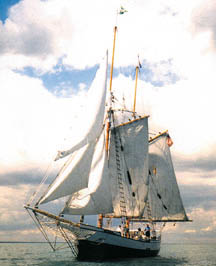Electrical work on the Madeline is ship-shape, thanks to 498'er
Date Posted: August 3 2001
"What am I doing here? Oh, I guess I'm an electrician by trade and a sailor at heart."
So said Bob Dost, 75, a retiree who helped build the Madeline, a modern replica of a schooner of the same name that sailed the Great Lakes after it was built in 1845.
Dost, a 52-year charter member of Traverse City IBEW Local 498, worked as a crewman aboard the schooner during the ship's most recent Great Lakes tour last month, when it participated in the tall ships flotilla during the Detroit 300 celebration. During that visit, we found Bob sitting atop the ship's forward cabin, greeting guests and telling them what he knows about life aboard the ship.
"This ship sails wonderfully," Dost said. "We've been through waves on the Great Lakes as high as 10 feet and it rides well. It's a very tight ship."
The new Madeline was built between 1985 and 1990, when 165 volunteers performed 40,000 hours of work to create the 92-foot, two-masted, vessel in Traverse City. Owned by the Maritime Heritage Alliance of Northern Michigan, the replica ship was built to educate and serve as a goodwill ambassador for the Grand Traverse Region.
When it isn't touring Great Lakes ports, the Madeline is berthed at Clinch Marina in downtown Traverse City, and open to all visitors.
Its volunteer builders learned the craft of traditional shipbuilding, and its crew of nine volunteer sailors continue to learn about the work that's necessary to sail a 160-year-old schooner.
The ship is a combination of the old and the new, and it's evident that there's a lot to be said for modern building techniques, materials and technology.
Like the original, the keel, frames, masts and spars were built of white oak - it's native to northern Michigan, and the wood is strong and naturally rot resistant. Unlike the original ship, the replica vessel's planking and deck are pressure-treated, two-inch native pine. The original lines would have been made of hemp, today her rigging uses steel cable and nylon rope.
Traditionally, sails were made of tanbark-treated cotton canvas - today's Madeline has lighter and more durable Dacron sheets.
The modern Madeline also has electricity - thanks to the work of Dost. He made the electrical panels, and wired the ship's two 12-volt marine batteries to power lights, sonar, the depth-finder and the marine radio while the vessel is under sail. Dost also wired the ship's alternator to carry the load when the engine is running, as well as the hook-up for shore power while they're docked.
"I never kept track of the time it took to do it all," he said. "They just kept adding things, and I had to find places to hide the wire as best I could. Now that it's done, there's always maintenance on a boat."
The ship's master on this voyage was Bruce Lehman, a former Coast Guard sailor and a former medical technician, who said he's reached a point in his life where "I figured I'd sail schooners."
"Bob's the first guy we call when we have a problem," the Madeline's skipper said. "We always run into problems with wiring up to the different ports, and Bob always knows how to fix it. He fixes that and just about everything else."
The original Madeline was a freight-carrying vessel built in Fairport, Ohio for her owners on Mackinac Island, which was the home port for the first 17 years of her existence.
She sailed all the Great Lakes, carrying barrels of fish, salt and other commodities to and from ports.
In the summer of 1847, the Madeline served as a temporary replacement for the schooner Ocean, a government lightship stationed in the Straits of Mackinac that needed to undergo repairs. In the winter of 1851-52, the Madeline's hold served as the first schoolhouse in the Traverse City region, and later the ship carried settlers to Beaver Island.
The Madeline was sold to new owners in Milwaukee in 1862, and several years later she was abandoned and probably ended her days settling quietly in the mud of one of the Milwaukee rivers.
"One of the reasons they built this ship was to make sure the skills and knowledge of shipbuilding are passed on," Lehman said. "We're also passing on the history of these schooners. They really opened up coastal Michigan to trade and development, and because of the good water transportation, those communities were settled long before the inland cities. These schooners played an important role in that development."

THE REPLICA SCHOONER Madeline was one of the tall ships that visited Detroit last month, and one of her crew members was Bob Dost, an IBEW Local 498 retiree. Unfortunately, our digital photo of Bob aboard the ship sailed away on our hard drive, never to be seen again.
